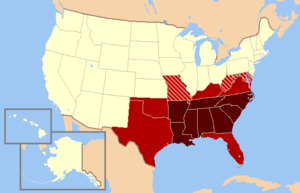
| This article is part of a series on the |
| Culture of the United States |
|---|
 |
| Society |
| Arts and literature |
| Other |
| Symbols |
|
United States portal |
The culture of the Southern United States, Southern culture, or Southern heritage, is a subculture of the United States. From its many cultural influences, the South developed its own unique customs, dialects, arts, literature, cuisine, dance, and music.[2] The combination of its unique history and the fact that many Southerners maintain—and even nurture—an identity separate from the rest of the country has led to it being one of the most studied and written-about regions of the United States.
During the 1600s to mid-1800s, the central role of agriculture and slavery during the colonial period and antebellum era economies made society stratified according to land ownership. This landed gentry made culture in the early Southern United States differ from areas north of the Mason–Dixon line and west of the Appalachians. The upland areas of the South were characterized by yeoman farmers who worked on their small landed property with few or no slaves, while the lower-lying elevations and Deep South was a society of more plantations worked by African slave labor. Events such as the First Great Awakening (1730s–1750s), would strengthen Protestantism in the South and United States as a whole. Communities would often develop strong attachment to their churches as the primary community institution.
- ^ Williamson, David (June 2, 1999). "UNC-CH surveys reveal where the 'real' South lies" (Press release). University of North Carolina at Chapel Hill. Archived from the original on June 23, 2020. Retrieved June 20, 2020.
- ^ Richard A. Peterson (1999-12-15). Creating Country Music: Fabricating Authenticity. University of Chicago Press. p. 9. ISBN 978-0-226-66285-5.
© MMXXIII Rich X Search. We shall prevail. All rights reserved. Rich X Search
